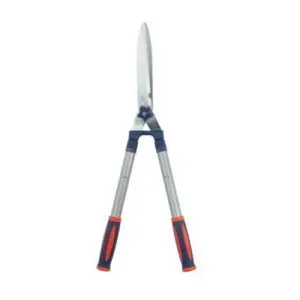First off, let’s agree which garden shears we’re talking about. The term ‘shears’ is sometimes used to describe short blade pruners and loppers. For this guide we are focussing on long-blade garden shears only; those used mostly for straight hedge trimming.
It’s easy to recognise garden hedge shears – manual shears look like a giant pair of scissors, and electric shears have a long cutting ‘blade’ or series of cutting teeth of around 50cms.
The longer blades of hedge shears are designed for cutting softer material (leaves and foliage) in straight lines.
Although most electric shears will handle woody stems, for tough stem and branch cutting, you’ll need a pair of short-blade shears, pruners or loppers.
For rounded shapes, complex topiary and curves, you’ll need a pair of shorter blade topiary shears.
Long blade hedge shears are ideal for trimming and cutting long straight hedges, square and boxy hedge shapes, and soft shrubs and perennials - quickly and efficiently.
Manual or electric?
When it comes to hedge and foliage trimming, the choice of whether to go manual or electric is a personal one. Some gardeners prefer the feeling of cutting with manual shears, others prefer the speed of electric hedge trimmers.
If you have a very large hedge or multiple hedges to cut, you may prefer the efficiency of electric. Take a look at our guide to electric hedge trimmers and cutters here.
Large evergreen hedges like laurel may respond better to pruning with short blade shears or secateurs to avoid cutting through the leaves and exposing cut edges.
This guide covers general maintenance shearing, rather than hedge renovation or reshaping.
Preparation
- Check for nesting birds. It is an offence to destroy the nests of wild birds, so don’t undertake hedge trimming until birds have fledged and nests are empty.
- Clear the space around and underneath your hedges and place a tarpaulin or old sheet(s) along and slightly underneath your hedge to catch your cuttings. This will make clearing up easier once you’ve finished trimming.
- If you are working at height, use a sturdy and stable set of ladders or step ladders. Alternatively, use manual telescoping shears or long reach attachments if they give you enough reach.
- Make sure you are wearing the correct PPE, including boots, gloves and eye protection.
- Have string and canes to hand for levelling.
Set your level
Set up a string line at ground level to give you a guide to follow and ensure you cut in a straight line and to the right depth.
You are aiming to remove all the growth that is less than a year old. Don’t set your line too far back that you end up removing too much of the stem. This can lead to exposing bald patches which can look unsightly – especially on conifers and leylandii which will not regrow.
Set another string line at the top of the hedge to your preferred height following the same rules above – to ensure you only cut the last year’s growth and have a nice straight finish across the top.
For very high hedges, it is a good idea to leave the bottom of the hedge slightly wider than the top to ensure light can reach the whole plant.
Start cutting
- Start at the sides from the bottom and work up. Use sweeping ‘arcs’ if using electric shears, but again, work from the bottom sweeping upwards.
- Check you progress every so often. You might want to start by taking a small amount of foliage off, then once you’re happy, return for another cut. Look down your string lines to check you are cutting in a straight line and adjust as needed.
- Tackle the top last, cutting only to the base of the new growth and to your string line.
- Brush the excess trimmings off the top of your hedge for a neat finish and to prevent them browning on the hedge and spoiling the look.
This process will give you a right-angled hedge with a sharp ‘corner’ between the front and top of your hedge. If you want a softer curved look, use topiary shears to smooth the corner off.
Once you have cleared away the clippings, you can add a layer of mulch to the base of the hedge to help ensure healthy regrowth – and to provide a visually pleasing finish.
Don’t forget to water your hedge if the weather has been hot and dry.










